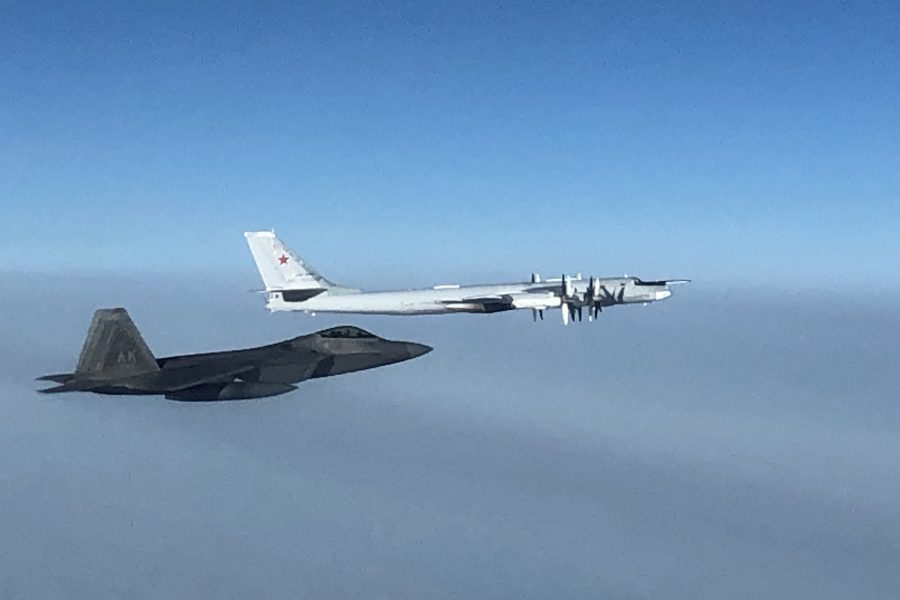Russia hasn’t stepped up its mock bomber runs at the U.S./Canadian landmass during its invasion of Ukraine, but cyber penetrations are up, indicating some “preparation of … the battlefield” is underway, U.S. Northern Command and North American Aerospace Defense Command commander Gen. Glen D. VanHerck reported.
He also discussed the “episodic” U.S. strategy in the Arctic and said it’s only a matter of time before North Korea builds enough intercontinental ballistic missiles that it could overwhelm current U.S. missile defenses.
“I have not witnessed anything towards the homeland that would be provocative,” said VanHerck April 25, referencing recent Russian military activity.
Since Russia’s invasion of Ukraine—indeed, for the last couple of years—Russian “bomber activity has been within … what I would consider historical norms.” He added that he’s seen nothing “that would give me any concerns” about changes in Russian operations in his theater.
The height of Russian bomber approaches to the North American landmass was “back in ‘20, I believe,” VanHerck continued. In 2021 and 2022, “What we’re seeing is … basically the average over the last decade or so; nothing too significant,” he said. He’s also seen no unusual “messaging” in the behavior of Russian forces on the periphery of the U.S.
However, “As you’ve seen in the public domain, it’s clear that Russian cyber activity in the [U.S.] homeland” can be construed as, “what I would [call], ‘preparation of the potential battlespace’,” VanHerck said. “But I’m not seeing anything that gives me pause right now from the air domain or the sea domain.” He did not elaborate on Russian intrusions or activity, except to reiterate that U.S. government and commercial information systems are under daily attack. Much of this is classified, he said.
Overall, he said, “I’m comfortable with our current posture based on indications and warning.”
VanHerck noted that he doesn’t control what aircraft the services and Canada use to perform the mission of intercepting bombers or unidentified aircraft that enter the North American Air Defense Identification Zone. Some Air Force leaders have suggested that using the F-22 for these missions out of Alaska burns up precious hours on that type, and that a less-costly alternative might be needed.
“It’s really a geography issue,” he said, and depends “on what platform is sitting alert” in proximity to the incursion. “I would point out that we utilize F-16s, and F-15s, and F-22s, and Canadian CF-18s to do our NORAD homeland defense mission,” Van Herck said. “It just happens to be that our platforms in Alaska that sit alert are the F-22s.”
His requirement to do homeland defense, as the NORTHCOM combatant commander, is for “long range, loiter time, an airplane that is a domain awareness sensor that could share data rapidly, and provide weapons to defend the homeland.”
VanHerck said he detects no “tensions” in the Arctic, except in the form of Russian rhetoric about its rights in the region and its development of a robust “capability to operate” there.
“You’ve got to be present to have tension, candidly,” he said. And I haven’t seen that. We haven’t been there, … having … confrontational challenges within the Arctic.”
VanHerck said the U.S. strategy for now is to have an “episodic” presence in the region, occasionally doing exercises and demonstrating “readiness and responsiveness” showing that U.S. forces are capable of operating in the region, but not necessarily present “24/7, 365.”
There’s the “possibility of friction” and “the possibility of conflict and crisis” as China styles itself as a “near Arctic” nation, and Russia makes claims in the region, and both seek “to change the international norms” and “rules-based order” that have prevailed in the Arctic since WWII, VanHerck said.
“But I don’t see specific tension, if you will, playing out in the military dimension right now” in the Arctic, he said.
Asked about the threat posed by North Korea’s missiles, VanHerck said his command has “the capability today to defend our homeland … against a limited threat.” North Korea is clearly trying to “develop capability” with ICBMs and “decoys, those kinds of things,” and will, “at some point, exceed the capacity of the current ground-based defense systems that we have” to defend against them.
That is why it’s so crucial to keep next-generation interceptor on time and on target, VanHerck added.
“It will give me additional capacity in the form of 20 additional interceptors, and also additional capability and reliability.” There’s a service life extension program underway for the current defensive system, he said, “which gives me additional capacity, as well.”
Given the current threat and program upgrades, “all of that combined leads me to believe that, today, we’re in a good position. We just have to stay on course” with upgrades to the system, he said.
